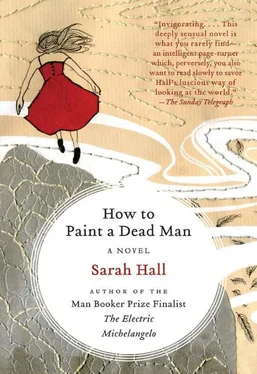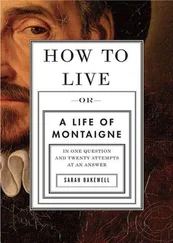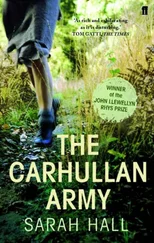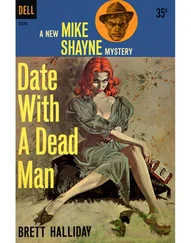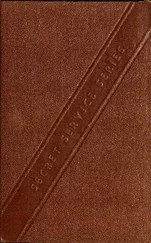Sarah Hall - How to Paint a Dead Man
Здесь есть возможность читать онлайн «Sarah Hall - How to Paint a Dead Man» весь текст электронной книги совершенно бесплатно (целиком полную версию без сокращений). В некоторых случаях можно слушать аудио, скачать через торрент в формате fb2 и присутствует краткое содержание. Год выпуска: 2009, Издательство: Harper Perennial, Жанр: Современная проза, на английском языке. Описание произведения, (предисловие) а так же отзывы посетителей доступны на портале библиотеки ЛибКат.
- Название:How to Paint a Dead Man
- Автор:
- Издательство:Harper Perennial
- Жанр:
- Год:2009
- ISBN:нет данных
- Рейтинг книги:4 / 5. Голосов: 1
-
Избранное:Добавить в избранное
- Отзывы:
-
Ваша оценка:
- 80
- 1
- 2
- 3
- 4
- 5
How to Paint a Dead Man: краткое содержание, описание и аннотация
Предлагаем к чтению аннотацию, описание, краткое содержание или предисловие (зависит от того, что написал сам автор книги «How to Paint a Dead Man»). Если вы не нашли необходимую информацию о книге — напишите в комментариях, мы постараемся отыскать её.
, Sarah Hall, "one of the most significant and exciting of Britain's young novelists" (
), delivers "a maddeningly enticing read... an amazing feat of literary engineering" (
).
How to Paint a Dead Man — читать онлайн бесплатно полную книгу (весь текст) целиком
Ниже представлен текст книги, разбитый по страницам. Система сохранения места последней прочитанной страницы, позволяет с удобством читать онлайн бесплатно книгу «How to Paint a Dead Man», без необходимости каждый раз заново искать на чём Вы остановились. Поставьте закладку, и сможете в любой момент перейти на страницу, на которой закончили чтение.
Интервал:
Закладка:
The tourists have arrived again, asking where the best restaurants are, and the pharmacists, the museums and shrines and the sites of the miracles, the stigmata and the bleeding hearts. They wear inappropriate attire to enter San Lorenzo and Father Mencaroni spends much of an afternoon removing baseball hats and asking ladies to cover their legs and heads. The visitors spoon gelato from little cups and look for sweet bunches of fragola to adorn their rented tables. ‘How preferable life is here,’ they say. In the market on Wednesday a cheer suddenly went up and Elemme told Annette that the railway workers were going to strike for better pay. Uncle Marcello is still battling with the invasion of greenfly. He suspects these to be of foreign origin, having come in with the shipments of orchid bulbs sent by Vincenzo from South America. They are making Chantilly patterns out of all the leaves. In defeat, he has ordered chloroform to clean the bottoms of the trays. She feels the minuscule legs creeping on her neck and ears when she goes to the greenhouses, or, if it is not the flies, it is Mauri. Such are their lives.
The cimitero di campagna is deserted. Overhead swallows flit and flurry, going to and from their nests under the tiled roofs of the ruins. The sky is busy with feathers. It is a hot day. Annette takes off her scarf and puts it into her pocket. Also in the pocket is a wooden rosary, given to her by the nuns at her confirmation ceremony when she was twelve. It is cheap. Its beads pinch the skin of her neck, and she does not like to wear it. The sun begins to melt like warm caramel through her hair. She wonders again exactly what colour her hair is, whether it has lightened or darkened over the years. Her mother will not confirm whether it is corn-yellow, or flax, or the auburn of summer wheat. It is a vanity to ask such things, her mother says, and what does it matter if she can’t see it? But there are so many subtle colours in Annette’s head. They span like rainbows across her mind.
Annette can hear the fizzle and tock of fireworks, and the minute laughter of the boys down at the lake. Mauri will be with them. Perhaps he will be diving down through the cool water in search of lost jewellery. Or he will be lying, naked as Adam, on a green rock. After her report, she says a prayer for her father and crosses the cemetery to visit Signor Giorgio.
She still does not know if Signor Giorgio has a family to care for his niche. In the classroom he never mentioned a daughter or a granddaughter, living close by, or in the north. The sole evidence is that Tommaso has seen a weeping woman leaving the tomb. Annette has only ever heard someone taking a photograph close by-the pop of a shutter, the clicking of winding gear. Perhaps an admirer of his paintings. She wonders if the other children remember the artist as she does. She does not often see her old friends to ask. When they rush past her in the market on their way to school or on the way to mass they call to her, ‘Hello Netta, goodbye Netta.’ That is all. Perhaps they have forgotten the lessons, on how to copy a figure, how to paint the foam of the breaking sea. She sometimes pictures the Dutch still-lifes. She imagines elaborate bouquets, containing cherries and nesting parrots and English willow, all of this held in a large transparent urn, like a world made of glass. She can recall her tutor’s gentle instructions. ‘Do not be afraid to paint the reverse side of the sunflower,’ he once said. ‘It is just as worthy of your attention. You will already know the strength of its neck, how it keeps turning to face the sun wherever the sun is in the sky.’
His shadowy tomb is like the third season, even though it is summer. Dry leaves have blown inside, and crisp and curl on the floor, and the place smells smoky, like the smoke of Signor Giorgio’s clothes. The rustling of the beech trees by the cimitero gate is hushed. She has already told Signor Giorgio that in previous times beech leaves were used to stuff mattresses, and that the voices of lovers who once whispered under the trees can sometimes be heard whispering inside the bolsters. The sepulchre is a good place to come. It feels restful. His bones must have settled, she thinks. Into the bottle, which he gave her and she has given back, she places a single chrysanthemum, the first of the season. They will continue to flourish through to All Souls’ Day. ‘You are already dead,’ she says. ‘I do not wish it.’
As she leaves the tomb she can hear that she is not alone after all. Someone is whistling nearby. The tune has no melody, and the scale slides randomly up and down. It is a strange sound for the cimitero. She is used to the recital of elegies, to crying or prayers. She has heard singing from the old women who come to sweep the pathways, but only hymns. The whistling is too bold. Perhaps there will soon be an interment, she thinks. Perhaps the peck-deads are working in the corner, preparing a new chamber. It is hard to know from which corner the whistling is coming. She turns and tries to place it. After a moment it stops. Perhaps the peck-deads have seen her. But there is nothing, no footsteps, no respectful salutation to indicate neighbourly proximity. She wonders, was it only the warbling and trilling of a bird in the tall beeches beyond the little city of the dead? Perhaps.
She puts on her headscarf and ties it under her chin. She should not have taken it off; it is an informality of which her mother would not approve. She calls good day and takes a step towards the gate. The whistling begins again, closer this time, directly behind her. Or no, directly in front of her. She stands still. How strange. The notes are so agile and light; they skim round the marble sculptures and commemorative pictures like something winged and flying. If Tommaso were not sick, if he were here, he could be playing a trick. But he has never really been able to approach her stealthily, even with bare feet. She can always hear the scrape of his heels, his rustling T-shirt, his excited breath. She is sure he is in bed, reading a comic, or writing a story about bicycle races.
Again, the whistling stops. The warm air drifts. She can smell an extinguished candlewick, or the tannin of the leather factory in the next valley, a brief bitter scent. A cloud sails overhead on a high, rapid current. The sun disappears and returns to its full heat. Someone is here. She can feel it. Someone is here in the cimitero but will not speak or be polite. There is another shadow. She feels pressure, a pressure no greater than the shadow cast by one of the angels on the marble plinths. But this is a shadow coming from beneath, or within. Though the sun blazes hot on her head, she feels the shadow creeping up her legs. It cools her insides. She catches her breath and tries to divine a presence. But there’s no ache in the air of someone following a lover. There is no mood of ill will, as when a pickpocket works the market. There is no gesture of friendship, like that of the accordion player from Toulouse, who sang ‘Remember Me’ to her after she had given him a coin.
The shadow has no mood or purpose. No one is advancing to rest a hand on her shoulder. No one is preparing to greet her or say, yes, the day is fine. No one is slipping shyly away through the rusty gates, leaving the hinges creaking softly behind them. The shadow has not moved — it is simply attending to her, chilling her warm skin, spreading into her core.
Her heart begins to shrink. Perhaps. Perhaps it is Him. But he has never come so far. He has never followed her further than the market, which is close to San Lorenzo, close to his slippery lair in the oil paint. If her little brother were here, he could hold her hand and tell her what he sees. He could even calculate the distance of the cimitero from the church, saying it is approximately a kilometre, or it is five furlongs, having copied the charts on the walls of the Montessori, and she might take comfort in this. How far can the Bestia walk when he stirs within the old varnish and releases himself from the tarnished cage? To the greenhouse garden where her father was killed? To the edge of the summer theatre where he watches Annette on her stool? Here?
Читать дальшеИнтервал:
Закладка:
Похожие книги на «How to Paint a Dead Man»
Представляем Вашему вниманию похожие книги на «How to Paint a Dead Man» списком для выбора. Мы отобрали схожую по названию и смыслу литературу в надежде предоставить читателям больше вариантов отыскать новые, интересные, ещё непрочитанные произведения.
Обсуждение, отзывы о книге «How to Paint a Dead Man» и просто собственные мнения читателей. Оставьте ваши комментарии, напишите, что Вы думаете о произведении, его смысле или главных героях. Укажите что конкретно понравилось, а что нет, и почему Вы так считаете.
